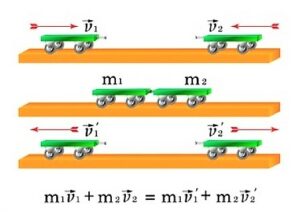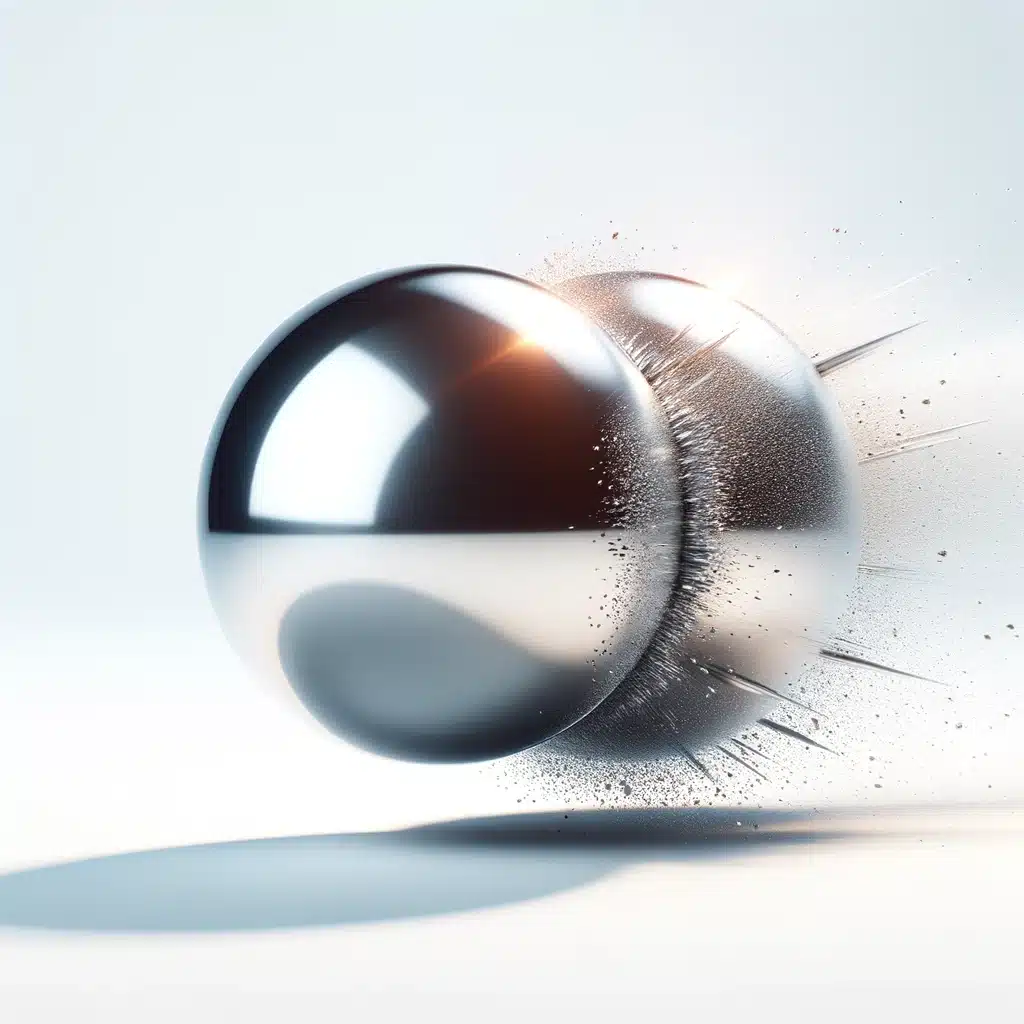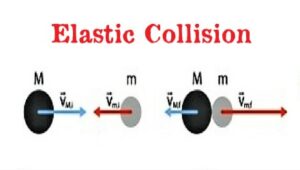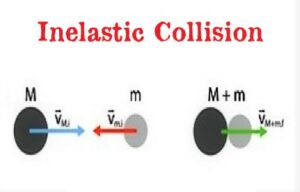The article discusses different formulas and problems on how to find momentum after collision.
An object’s velocity changes during a collision due to external force from another object. The velocity change causes a change in momentum after collision. So, we can find the momentum after collision using the impulse formula, laws of conservation of momentum, and conservation of energy.
The momentum before the collision is Pi =mu. The momentum after collision is also found by estimating a change in an object’s velocity v after the collision. Pf = mv
Suppose a stationary pull ball having a mass of 8kg is hit by another ball. After the collision, the ball is in motion at 5m/s. Determine the pool ball’s momentum after the collision.

Given:
m = 8kg
v = 5m/s
To Find: ∆P =?
Formula:
∆P = Pf – Pi
Solution:
The momentum of ball after collision is calculated as,
∆P = Pf – Pi
∆P = mv – mu
Since pool ball at rest, i.e., u=0
∆P = mv
Substituting all values,
∆P = 8 x 5
∆P = 40
The pool ball’s momentum after collision is 40kg⋅m/s.
Read more about How to Find Net Force from Momentum.
How to Find Momentum after Collision Formula?
The momentum after collision is determined using the impulse formula.
When we speak about finding momentum after collision of only one object, we can calculate it using the impulse formula. Impulse is the momentum change after collision due to the external force. Since collisions occur rapidly, it is tough to calculate the external force applied and time separately.
Once we computed momentum before Pi and after collision Pf, we can find impulse in terms of external force by another object as,
“Impulse (∆P) is the product of external force F and time difference (∆t) in which change in momentum occurs.”

Mathematically,
∆P = F ∆t
Pf – Pi = F ∆t
Read more about Types of Forces.
A football kicked the football having a mass of 5kg on the frictionless ground surface with a force of 30N over 5 sec. What is the velocity and momentum of football after kicking?
Given:
m = 5kg
F = 30N
∆t = 5 sec
To Find:
- v2=?
- Pf=?
Formula:
- P = mv
- ∆P = F ∆t
Solution:
The momentum of football before kicking is,
Pi = m1v1
Since football is at rest. i.e., v1=0
Therefore, Pi = 0
The momentum of football before kicking is zero.
The momentum of football after kicking is calculated using the Impulse formula.
∆P = F ∆t
Pf-Pi = F ∆t
Since Pi = 0
Pf = F ∆t
Substituting all values,
Pf = 30 x 5
Pf = 150
The momentum of football after kicking is 150kg⋅m/s
The velocity of football after kicking is,
m2v2 = 150
v2 = 150/5
v2 = 30
The velocity of football after kicking is 30m/s.
Read more about How to Find Net Force?
How to Find Total Momentum of Two Objects after Collision?
The total momentum of two objects after collision is estimated using the law of conservation of momentum.
When two objects collide, their respective momentum changes because of their velocities, but their total momentum after collision remains the same. The total momentum after collision is summed by adding all the respective momentums of colliding objects.
In a closed or isolated system, when two objects holding different masses and velocities collide, they may move with each other or away, depending on the types of a collision – such as inelastic collision or elastic collision.


(credit: shutterstock)
After the collision, their momentum, which is the product of their masses and velocities, is also varied. But when talking about the total momentum of an isolated system, it remains unchanged. During the collision, whatever momentum one object loses is gained by another object. That’s how the total momentum of colliding objects is conserved.
Suppose momentum of object 1 is P1 = m1u1
Momentum of object 2 is P2 = m2u2
Momentum of both objects before collision is Pi = P1 + P2 = m1u1 + m2+u2
If there is no net force involved during the collision, then momentum after collision Pf of both objects remains the same as before the collision.
Therefore, As per law of conservation of momentum,
Pi = Pf
m1u1 + m2+u2 = m1v1 + m2+v2 ……………………. (*)
Notice velocities of both objects changed after collision from u to v. That shows their respective momentum after collision also gets changed.
For an isolated system,
“The total momentum after collision is exactly as before collision as per the law of conservation of momentum.”

(credit: shutterstock)
Suppose two marble pebbles having masses 10kg and 5kg moving at 8m/sec and 12 m/sec respectively; collide with each other. After the collision, both pebbles move away from each other with the same masses. If one pebble moves away with a velocity of 10m/sec, what is the second pebble’s velocity?
Given:
m1 = 10kg
m2 = 5kg
u1= 8m/sec
u2= 12m/sec
v1= 10m/sec
To Find: v2 =?
Formula:
m1u1 + m2+u2 = m1v1 + m2+v2
Solution:
The law of conservation of momentum calculates the velocity of the second pebble,
For isolated systems when no net force acts,
m1u1 + m2+u2 = m1v1 + m2+v2
Note that second objects move opposite to the first object. Therefore, the momentum of the second object must be negative.
Substituting all values,
10 x 8 + (- (5 x12) = 10 x 10 + (-(5xv2)
80 – 60 = 100 -5v2
5v2 = 100 -20
v2 = 80/5
v2 = 16
The velocity of the second pebble after the collision is 16m/sec.
Read more about Relative Velocity.
How to Find Momentum after Elastic Collision?
The momentum after elastic collision is estimated using the law of conservation of energy.
The total momentum is conserved during the collision. The kinetic energy of a respective object may change after the collision, but the total kinetic energy after elastic collision stays the same. So, we can find momentum after elastic collision utilizing the law of conservation of energy.

Elastic collision

(credit: shutterstock)
When the collision between objects is elastic, the total kinetic energy is conserved.
As per law of conservation of energy,

Rearranging equation (*) by terms with m1 on one side and terms with m2 on other.

Now rearranging equation (#) by terms with m1 on one side and the terms with m2 on other and cancel ½ common factor,

Recognize the first term on the left hand side is ‘1’ in the above equation, we get.

………………. (1)
Substitute above equation into equation (*), to eliminate v2, we get

Finally rearrange above equation and solve for velocity v1 of object 1 after collision,

Substitute above equation into equation (1) velocity v2 of object 2 after collision,

Read more about Kinetic Energy.
When a 10kg ball moving at 2m/s elastically collides with another ball having mass 2kg oppositely moving at 4m/s. Calculate the final velocities of both balls after the elastic collision.
Given:
m1 = 10kg
m2 = 2kg
u1 = 2m/s
u2 = -4m/s
To Find:
- v1 =?
- v2 =?
Formula:

Solution:
The velocity of ball 1 after elastic collision is calculated as,

Substituting all values,

v1 = 0
That means, the elastic collision stopped the ball 1.
The velocity of ball 2 after elastic collision is calculated as,

Substituting all values,

v2= 6 m/s
That means the elastic collision changes the velocity of the second ball to 6m/s.
How to Find Momentum after Inelastic Collision?
The momentum after collision is determined using the law of conservation of momentum.
The total momentum is conserved during the collision. But the total kinetic energy of the system is also changed like the kinetic energy respective object, and the collision is said to be inelastic. So, we can find momentum after inelastic collision using the law of conservation of momentum.

If the collision is elastic, both objects move away from each other with different velocities v1, v2 in opposite directions.
But if the collision is inelastic, both objects move with one final velocity V in the same direction.
Therefore, the momentum Pf after inelastic collision becomes m1V + m2V or V(m1+m2)
So, the equation of conservation of momentum for inelastic collision is,
m1u1 + m2+u2 = V(m1+m2)
The formula for final velocity after inelastic collision is,
V=(m1u1 + m2+u2)/(m1+m2)
Two boys are playing on the playground slide in the park. The first boy having a mass of 20kg sliding at 10m/s on the slide. Since the first boy becomes slower at certain portions latterly collides with another boy having a mass of 30kg who slides down at 12 m/s. What will be the velocity of both boys who slide down together after collision?
Given:
m1 = 20kg
m2 = 30kg
u1 = 10m/s
u2 = 12m/s
To Find: V =?
Formula:
V=(m1u1 + m2+u2)/(m1+m2)
Solution:
The final velocity of both boys sliding after collision is calculated as,
V=(m1u1 + m2+u2)/(m1+m2)
Substituting all values,

V = 11.2
The final velocity of both boys sliding after an inelastic collision is 11.2m/s.
Quick Facts
What is momentum and why is it important in collisions?
A: Momentum is a fundamental concept in physics that describes the motion of an object. It is calculated by multiplying an object’s mass by its velocity. In collisions, momentum is important because it determines how objects interact and how their motion changes.
What is the law of conservation of momentum?
A: The law of conservation of momentum states that the total momentum of a system of objects remains constant if no external forces act on it. This means that the total momentum before a collision is equal to the total momentum after the collision.
How do you calculate the momentum of an object?
A: The momentum of an object is calculated by multiplying its mass (in kilograms) by its velocity (in meters per second). The formula for momentum is: momentum = mass × velocity.
What are elastic and inelastic collisions?
| Property | Elastic Collisions | Inelastic Collisions |
|---|---|---|
| Kinetic Energy | Conserved. Total kinetic energy before and after the collision is the same. | Not conserved. Total kinetic energy after the collision is less than before. |
| Momentum | Conserved. Total momentum before and after the collision remains constant. | Conserved. Total momentum before and after the collision remains constant, just as in elastic collisions. |
| Colliding Objects | Objects bounce off each other with no permanent deformation or generation of heat. | Objects may stick together or deform, generating heat and possibly sound or light. |
| Examples | Billiard balls colliding, an atom striking a perfectly rigid surface. | Car crashes, a lump of clay hitting a wall and sticking to it. |
| Energy Conversion | No conversion of kinetic energy into other forms of energy. | Kinetic energy is partially converted into other forms of energy, such as heat, sound, or potential energy (in the case of deformation). |
| Mathematical Complexity | Relatively simple to calculate final velocities using conservation laws. | More complex due to the need to consider energy dissipation and possible sticking together of objects. |
| Post-Collision Velocities | Can be calculated precisely using conservation laws. | Less predictable; it often requires additional information about the energy conversion and possible sticking. |
| Coefficient of Restitution | Equal to 1 (perfectly elastic). | Less than 1, indicating some energy loss. |
| Real-World Occurrence | Rare—most real-world collisions have some degree of inelasticity. | Common, as most collisions convert some kinetic energy into other forms. |

Momentum in Elastic Collsion

Momentum in InElastic Collsion
What is the impulse-momentum theorem?
A: The impulse-momentum theorem states that the change in momentum of an object is equal to the applied impulse, which is the product of the force applied to the object and the time interval over which the force is applied.
What happens to the momentum of two objects in a collision?
A: In a collision between two objects, the momentum of the system is conserved. This means that the total momentum before the collision is equal to the total momentum after the collision. If the objects stick together after the collision, they move together with a combined momentum.
What is Newton’s third law and how does it relate to momentum?
A: Newton’s third law states that for every action, there is an equal and opposite reaction. In the context of collisions, this means that the forces exerted by the objects on each other are equal and opposite, resulting in a change in momentum for both objects.
How do you find the momentum after a collision?
A: To find the momentum after a collision, you need to calculate the final momentum of the system. This can be done by adding up the individual momenta of the objects involved in the collision. The formula for momentum is: momentum = mass × velocity.
What happens to the kinetic energy in a collision?
A: In general, the kinetic energy is not conserved in a collision. In an elastic collision, however, the kinetic energy is conserved, meaning that it remains the same before and after the collision. In an inelastic collision, some of the kinetic energy is lost as heat, sound, or deformation.

Is momentum conserved in all types of collisions?
A: Yes, momentum is conserved in all types of collisions. Whether it is an elastic or inelastic collision, the total momentum of the system before the collision is equal to the total momentum after the collision.
Also Read:
- How to find velocity with constant acceleration
- How to find tangential acceleration
- How to find molar mass from molarity
- How to find wavelength of transverse wave
- How to find velocity with height
- How to find frequency of transverse wave
- How to find the area of a trapezoid 2
- How to find time with acceleration and distance
- How to find constant acceleration with distance and time
- How to find gravitational acceleration without mass

Hello, I’m Manish Naik completed my MSc Physics with Solid-State Electronics as a specialization. I have three years of experience in Article Writing on Physics subject. Writing, which aimed to provide accurate information to all readers, from beginners and experts.
In my leisure time, I love to spend my time in nature or visiting historical places.
Looking forward to connecting you through LinkedIn –